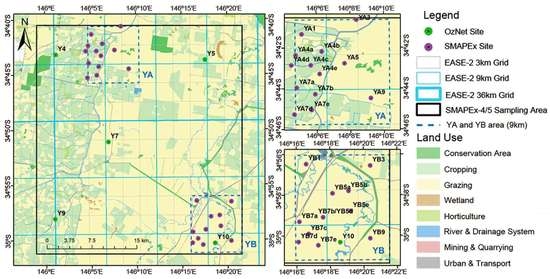NIR-Red Spectra-Based Disaggregation of SMAP Soil Moisture to 250 m Resolution Based on OzNet in Southeastern Australia
Abstract
:1. Introduction
2. Materials and Methods
2.1. Study Area and Data Collection
2.2. Assumptions and Applicability Domains of the NRSD Method
- Cloud-free conditions: In contrast with microwave, NIR and red spectra have relatively lower penetration through cloud. A cloud-free condition is recommended in this study, whereas the cloud-cover pixels can also be inputs to the NRSD method with poorer data quality.
- Precipitation-free conditions from 6:00 a.m. to 10:30 a.m.: The performance of the NRSD method is influenced by the mismatch of SMAP and MODIS overpass times. In this study, 6:00 a.m. SMAP soil moisture and 10:30 a.m. MODIS data were collected; thus, a precipitation-free condition within study area is preferred during the period. It should be noted that although precipitation can influence the performance of NRSD theoretically, it was not considered in this study because ancillary meteorological data were lacking.
- Relative heterogeneity of soil moisture within SMAP pixels: Low spatial variance of soil moisture results in less effective disaggregation methods because SMAP soil moisture itself can theoretically represent the soil moisture well at 36 km resolution homogeneous scales; thus, disaggregation methods may introduce redundant errors in such a situation.
- Mismatch of soil moisture sensing depth: The SMAP radiometer has a sensing depth of ~5 cm from the surface due to its strong penetration, whereas the optical sensor measures the surface skin. The NRSD method contains an assumption that soil moisture at the soil skin and at an ~5 cm depth from the top are correlated [27].
2.3. Flowchart of NRSD
2.4. NSMI: Normalized Soil Moisture Index
2.5. Disaggregation Method
2.6. Validation, Comparison and Evaluation
3. Results
3.1. Extraction of the Variance Conversion Factor
3.2. Disaggregated Soil Moisture
3.3. Validation and Comparison with DISPATCH
3.3.1. Overall Accuracy and Performance
3.3.2. Capacity Test for Spatial Representation
3.3.3. Assessments of the Algorithm Applicable Scope
4. Discussion
4.1. Performance of NSMI
4.2. Error in SMAP Data
5. Conclusions
Acknowledgments
Author Contributions
Conflicts of Interest
References
- Kerr, Y.H.; Waldteufel, P.; Wigneron, J.P.; Martinuzzi, J.; Font, J.; Berger, M. Soil moisture retrieval from space: The soil moisture and ocean salinity (SMOS) mission. IEEE Trans. Geosci. Remote Sens. 2001, 39, 1729–1735. [Google Scholar] [CrossRef]
- Entekhabi, D.; Jackson, T.J.; Njoku, E.G.; Oneill, P.; Entin, J.K. Soil moisture active/passive (SMAP) mission concept. In Proceedings of the Society of Photographic Instrumentation Engineers Conference on Optical Engineering+ Applications, San Diego, CA, USA, 10–14 August 2008.
- Jackson, T.J.; Vine, D.M.L.; Hsu, A.Y.; Oldak, A.; Starks, P.J.; Swift, C.T.; Isham, J.; Haken, M. Soil moisture mapping at regional scales using microwave radiometry: The southern great plains hydrology experiment. IEEE Trans. Geosci. Remote Sens. 1999, 37, 2136–2151. [Google Scholar] [CrossRef]
- Cho, E.; Choi, M. Regional scale spatio-temporal variability of soil moisture and its relationship with meteorological factors over the Korean Peninsula. J. Hydrol. 2014, 516, 317–329. [Google Scholar] [CrossRef]
- Hasan, S.; Montzka, C.; Rüdiger, C.; Ali, M.; Bogena, H.R.; Vereecken, H. Soil moisture retrieval from airborne L-band passive microwave using high resolution multispectral data. ISPRS J. Photogramm. Remote Sens. 2014, 91, 59–71. [Google Scholar] [CrossRef]
- Orth, R.; Seneviratne, S.I. Using soil moisture forecasts for sub-seasonal summer temperature predictions in Europe. Clim. Dyn. 2014, 43, 3403–3418. [Google Scholar] [CrossRef]
- Huszar, T.; Mika, J.; Loczy, D.; Molnar, K.; Kertesz, A. Climate change and soil moisture: A case study. Phys. Chem. Earth Part A Solid Earth Géod. 1999, 24, 905–912. [Google Scholar] [CrossRef]
- Wang, A.; Lettenmaier, D.P.; Sheffield, J. Soil moisture drought in China, 1950–2006. J. Clim. 2011, 24, 3257–3271. [Google Scholar] [CrossRef]
- Van Steenbergen, N.; Willems, P. Increasing river flood preparedness by real-time warning based on wetness state conditions. J. Hydrol. 2013, 489, 227–237. [Google Scholar] [CrossRef]
- Das, N.; Entekhabi, D.; Njoku, E.G.; Shi, J.; Johnson, J.T.; Colliander, A. Tests of the SMAP combined radar and radiometer algorithm using airborne field campaign observations and simulated data. IEEE Trans. Geosci. Remote Sens. 2014, 52, 2018–2028. [Google Scholar] [CrossRef]
- Schaefer, G.L.; Cosh, M.H.; Jackson, T.J. The USDA natural resources conservation service soil climate analysis network (SCAN). J. Atmos. Ocean. Technol. 2007, 24, 2073–2077. [Google Scholar] [CrossRef]
- Blumberg, D.G.; Freilikher, V.D.; Lyalko, I.V.; Vulfson, L.D.; Kotlyar, A.L.; Shevchenko, V.N.; Ryabokonenko, A.D. Soil moisture (water-content) assessment by an airborne scatterometer: The Chernobyl disaster area and the Negev Desert. Remote Sens. Environ. 2000, 71, 309–319. [Google Scholar] [CrossRef]
- Panciera, R.; Walker, J.P.; Jackson, T.J.; Gray, D.A.; Tanase, M.A.; Ryu, D.; Monerris, A.; Yardley, H.; Rudiger, C.; Wu, X. The soil moisture active passive experiments (SMAPEx): Toward soil moisture retrieval from the SMAP mission. IEEE Trans. Geosci. Remote Sens. 2014, 52, 490–507. [Google Scholar] [CrossRef]
- Jackson, T.J.; Bindlish, R.; Cosh, M.H.; Zhao, T.; Starks, P.J.; Bosch, D.D.; Seyfried, M.S.; Moran, M.S.; Goodrich, D.C.; Kerr, Y.H. Validation of soil moisture and ocean salinity (SMOS) soil moisture over watershed networks in the U.S. IEEE Trans. Geosci. Remote Sens. 2012, 50, 1530–1543. [Google Scholar] [CrossRef] [Green Version]
- Chan, S.; Bindlish, R.; Oneill, P.E.; Njoku, E.G.; Jackson, T.J.; Colliander, A.; Chen, F.; Burgin, M.; Dunbar, S.; Piepmeier, J. Assessment of the SMAP passive soil moisture product. IEEE Trans. Geosci. Remote Sens. 2016, 54, 4994–5007. [Google Scholar] [CrossRef]
- Alyaari, A.; Wigneron, J.P.; Ducharne, A.; Kerr, Y.; De Rosnay, P.; De Jeu, R.A.M.; Govind, A.; Bitar, A.A.; Albergel, C.; Munozsabater, J. Global-scale evaluation of two satellite-based passive microwave soil moisture datasets (SMOS and AMSR-E) with respect to land data assimilation system estimates. Remote Sens. Environ. 2014, 149, 181–195. [Google Scholar] [CrossRef] [Green Version]
- Alyaari, A.; Wigneron, J.P.; Ducharne, A.; Kerr, Y.; Wagner, W.; De Lannoy, G.J.M.; Reichle, R.H.; Bitar, A.A.; Dorigo, W.; Richaume, P. Global-scale comparison of passive (SMOS) and active (ASCAT) satellite based microwave soil moisture retrievals with soil moisture simulations (MERRA-land). Remote Sens. Environ. 2014, 152, 614–626. [Google Scholar] [CrossRef] [Green Version]
- Kerr, Y.; Alyaari, A.; Rodriguezfernandez, N.J.; Parrens, M.; Molero, B.; Leroux, D.; Bircher, S.; Mahmoodi, A.; Mialon, A.; Richaume, P. Overview of SMOS performance in terms of global soil moisture monitoring after six years in operation. Remote Sens. Environ. 2016, 180, 40–63. [Google Scholar] [CrossRef]
- Piepmeier, J.R.; Johnson, J.T.; Mohammed, P.N.; Bradley, D.; Ruf, C.S.; Aksoy, M.; Garcia, R.J.; Hudson, D.; Miles, L.; Wong, M. Radio-frequency interference mitigation for the soil moisture active passive microwave radiometer. IEEE Trans. Geosci. Remote Sens. 2014, 52, 761–775. [Google Scholar] [CrossRef]
- Kim, G.; Barros, A.P. Space-time characterization of soil moisture from passive microwave remotely sensed imagery and ancillary data. Remote Sens. Environ. 2002, 81, 393–403. [Google Scholar] [CrossRef]
- Kim, G.; Barros, A.P. Downscaling of remotely sensed soil moisture with a modified fractal interpolation method using contraction mapping and ancillary data. Remote Sens. Environ. 2002, 83, 400–413. [Google Scholar] [CrossRef]
- Reichle, R.H.; Entekhabi, D.; Mclaughlin, D. Downscaling of radio brightness measurements for soil moisture estimation: A four-dimensional variational data assimilation approach. Water Resour. Res. 2001, 37, 2353–2364. [Google Scholar] [CrossRef]
- Das, N.; Entekhabi, D.; Njoku, E.G. An algorithm for merging SMAP radiometer and radar data for high-resolution soil-moisture retrieval. IEEE Trans. Geosci. Remote Sens. 2011, 49, 1504–1512. [Google Scholar] [CrossRef]
- Wu, X.; Walker, J.P.; Das, N.; Panciera, R.; Rudiger, C. Evaluation of the SMAP brightness temperature downscaling algorithm using active–passive microwave observations. Remote Sens. Environ. 2014, 155, 210–221. [Google Scholar] [CrossRef]
- Wu, X.; Walker, J.P.; Rudiger, C.; Panciera, R. Effect of land-cover type on the SMAP active/passive soil moisture downscaling algorithm performance. IEEE Geosci. Remote Sens. Lett. 2015, 12, 846–850. [Google Scholar]
- Merlin, O.; Bitar, A.A.; Walker, J.P.; Kerr, Y.H. A sequential model for disaggregating near-surface soil moisture observations using multi-resolution thermal sensors. Remote Sens. Environ. 2009, 113, 2275–2284. [Google Scholar] [CrossRef] [Green Version]
- Merlin, O.; Bitar, A.A.; Walker, J.P.; Kerr, Y.H. An improved algorithm for disaggregating microwave-derived soil moisture based on red, near-infrared and thermal-infrared data. Remote Sens. Environ. 2010, 114, 2305–2316. [Google Scholar] [CrossRef] [Green Version]
- Merlin, O.; Escorihuela, M.J.; Mayoral, M.A.; Hagolle, O.; Bitar, A.A.; Kerr, Y.H. Self-calibrated evaporation-based disaggregation of SMOS soil moisture: An evaluation study at 3 km and 100 m resolution in Catalunya, Spain. Remote Sens. Environ. 2013, 130, 25–38. [Google Scholar] [CrossRef] [Green Version]
- Merlin, O.; Rudiger, C.; Bitar, A.A.; Richaume, P.; Walker, J.P.; Kerr, Y.H. Disaggregation of SMOS soil moisture in southeastern Australia. IEEE Trans. Geosci. Remote Sens. 2012, 50, 1556–1571. [Google Scholar] [CrossRef] [Green Version]
- Molero, B.; Merlin, O.; Malbeteau, Y.; Bitar, A.A.; Cabot, F.; Stefan, V.; Kerr, Y.H.; Bacon, S.; Cosh, M.H.; Bindlish, R. SMOS disaggregated soil moisture product at 1 km resolution: Processor overview and first validation results. Remote Sens. Environ. 2016, 180, 361–376. [Google Scholar] [CrossRef]
- Kim, J.; Hogue, T.S. Improving spatial soil moisture representation through integration of AMSR-E and MODIS products. IEEE Trans. Geosci. Remote Sens. 2012, 50, 446–460. [Google Scholar] [CrossRef]
- Carlson, T.N.; Gillies, R.R.; Perry, E.M. A method to make use of thermal infrared temperature and NDVI measurements to infer surface soil water content and fractional vegetation cover. Remote Sens. Rev. 1994, 9, 161–173. [Google Scholar] [CrossRef]
- Carlson, T.N. An overview of the "triangle method" for estimating surface evapotranspiration and soil moisture from satellite imagery. Sensors 2007, 7, 1612–1629. [Google Scholar]
- Richardson, A.J.; Weigand, C. Distinguishing vegetation from soil background information. Photogramm. Eng. Remote Sens. 1977, 43, 1541–1552. [Google Scholar]
- Huete, A.R.; Jackson, R.D.; Post, D.F. Spectral response of a plant canopy with different soil backgrounds. Remote Sens. Environ. 1985, 17, 37–53. [Google Scholar] [CrossRef]
- Ghulam, A.; Qin, Q.; Zhan, Z. Designing of the perpendicular drought index. Environ. Earth Sci. 2006, 52, 1045–1052. [Google Scholar] [CrossRef]
- Abduwasit, G.; Qiming, Q.; Tashpolat, T.; Zhaoliang, L. Modified perpendicular drought index (MPDI): A real-time drought monitoring method. ISPRS J. Photogramm. Remote Sens. 2007, 62, 150–164. [Google Scholar]
- Amani, M.; Parsian, S.; Mirmazloumi, S.M.; Aieneh, O. Two new soil moisture indices based on the NIR-red triangle space of Landsat-8 data. Int. J. Appl. Earth Obs. Geoinform. 2016, 50, 176–186. [Google Scholar] [CrossRef]
- Smith, A.B.; Walker, J.P.; Western, A.W.; Young, R.; Ellett, K.M.; Pipunic, R.; Grayson, R.; Siriwardena, L.; Chiew, F.H.S.; Richter, H. The Murrumbidgee soil moisture monitoring network data set. Water Resour. Res. 2012, 48. [Google Scholar] [CrossRef]
- SMAPEx Project. Available online: www.smapex.monash.edu.au (accessed on 27 October 2016).
- NASA Distributed Active Archive Center at NSIDC. Available online: https://nsidc.org/daac/ (accessed on 27 October 2016).
- NASA Reverb. Available online: https://reverb.echo.nasa.gov (accessed on 27 October 2016).
- OzNet Hydrological Monitoring Network. Available online: www.oznet.org.au (accessed on 27 October 2016).
- Baret, F.; Clevers, J.G.P.W.; Steven, M.D. The robustness of canopy gap fraction estimates from red and near-infrared reflectances : A comparison of approaches. Remote Sens. Environ. 1995, 54, 141–151. [Google Scholar] [CrossRef]
- Huete, A.R.; Post, D.F.; Jackson, R.D. Soil spectral effects on 4-space vegetation discrimination. Remote Sens. Environ. 1984, 15, 155–165. [Google Scholar] [CrossRef]
- Galvao, L.S.; Vitorello, I. Variability of laboratory measured soil lines of soils from southeastern Brazil. Remote Sens. Environ. 1998, 63, 166–181. [Google Scholar] [CrossRef]
- Baret, F.; Jacquemoud, S.; Hanocq, J.F. The soil line concept in remote sensing. Remote Sens. Rev. 1993, 7, 65–82. [Google Scholar] [CrossRef]
- Yoshioka, H.; Miura, T.; Dematte, J.A.M.; Batchily, K.; Huete, A.R. Soil line influences on two-band vegetation indices and vegetation isolines: A numerical study. Remote Sens. 2010, 2, 545–561. [Google Scholar] [CrossRef]
- Amani, M.; Mobasheri, M.R. A parametric method for estimation of leaf area index using Landsat ETM+ data. Gisci. Remote Sens. 2015, 52, 478–497. [Google Scholar] [CrossRef]
- Moran, M.S.; Clarke, T.R.; Inoue, Y.; Vidal, A. Estimating crop water deficit using the relation between surface-air temperature and spectral vegetation index. Remote Sens. Environ. 1994, 49, 246–263. [Google Scholar] [CrossRef]
- Noilhan, J.; Planton, S. A simple parameterization of land surface processes for meteorological models. Mon. Weather Rev. 1989, 117, 536–549. [Google Scholar] [CrossRef]
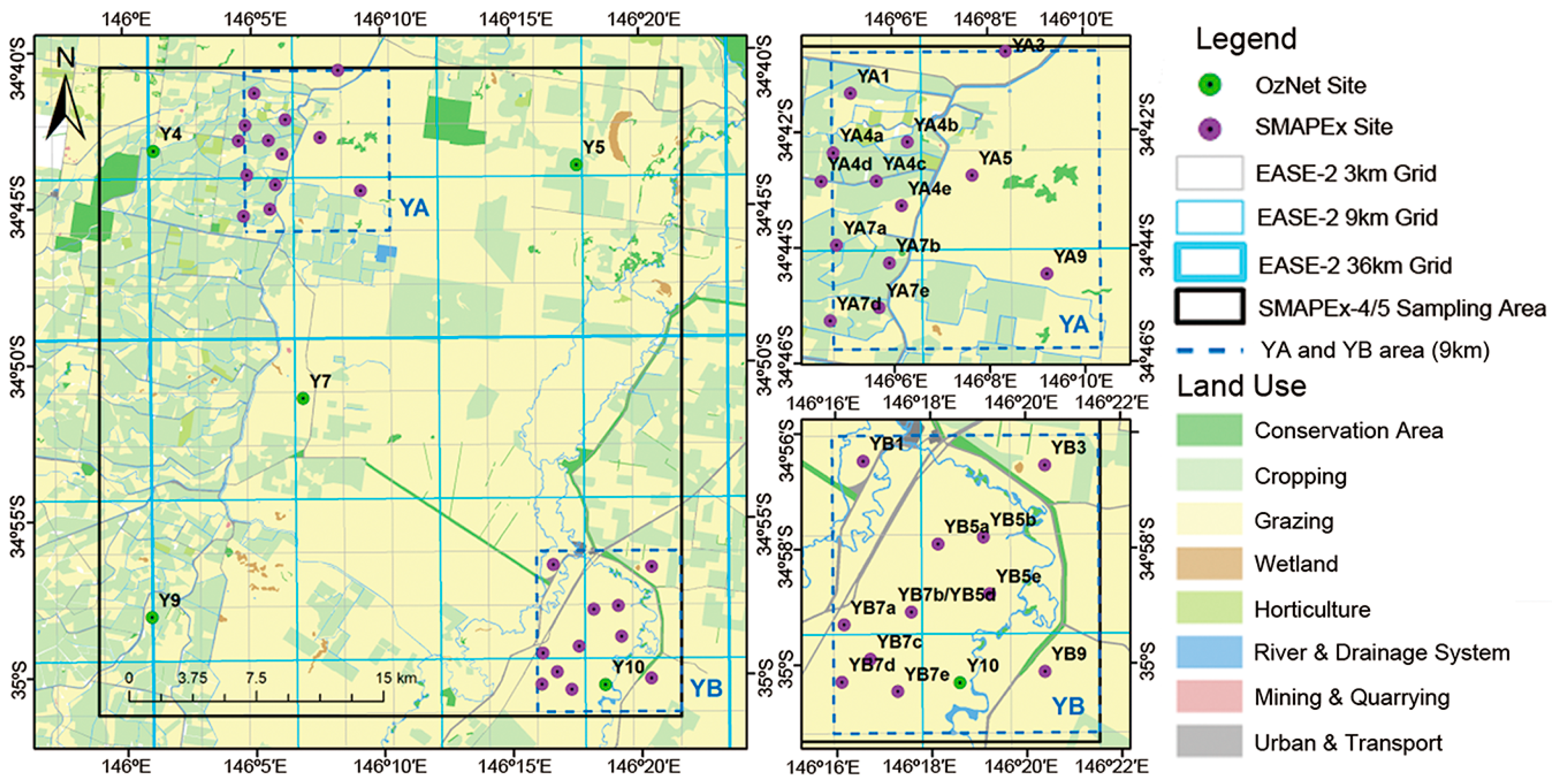

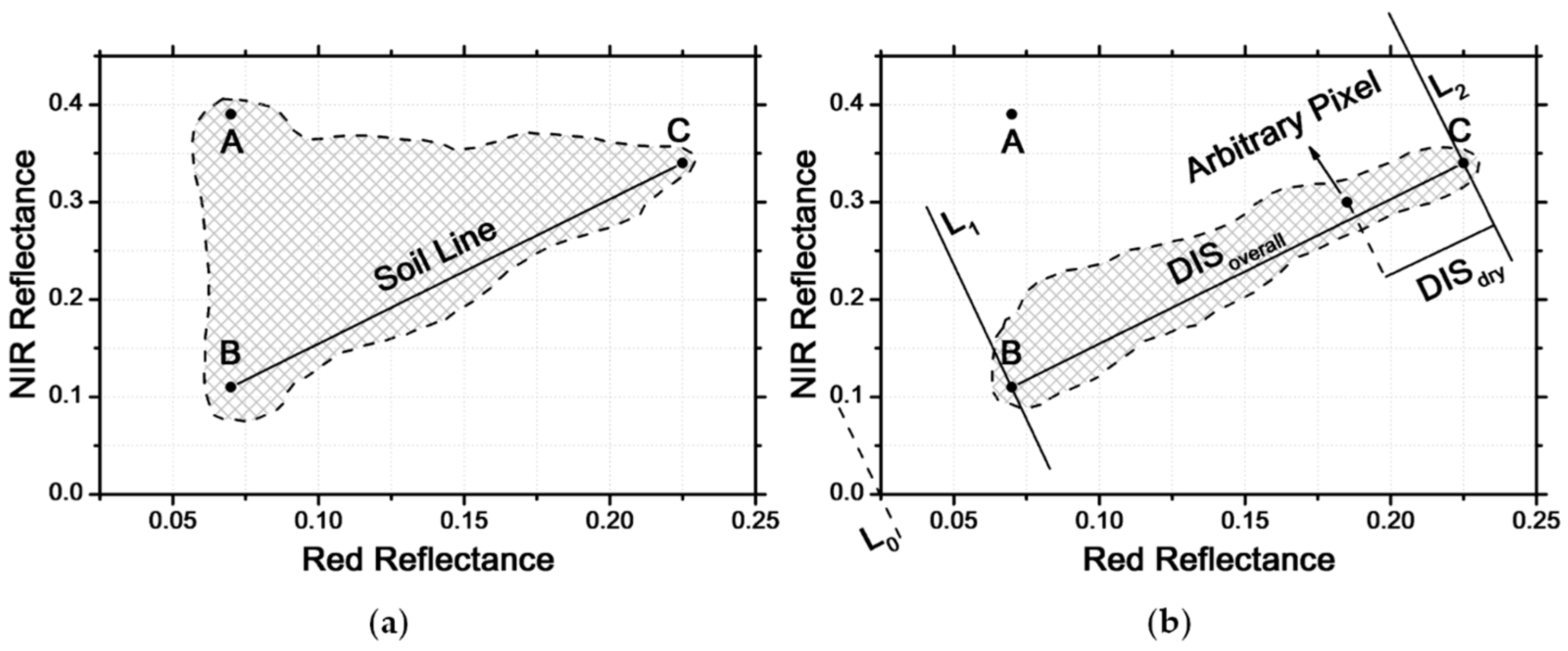
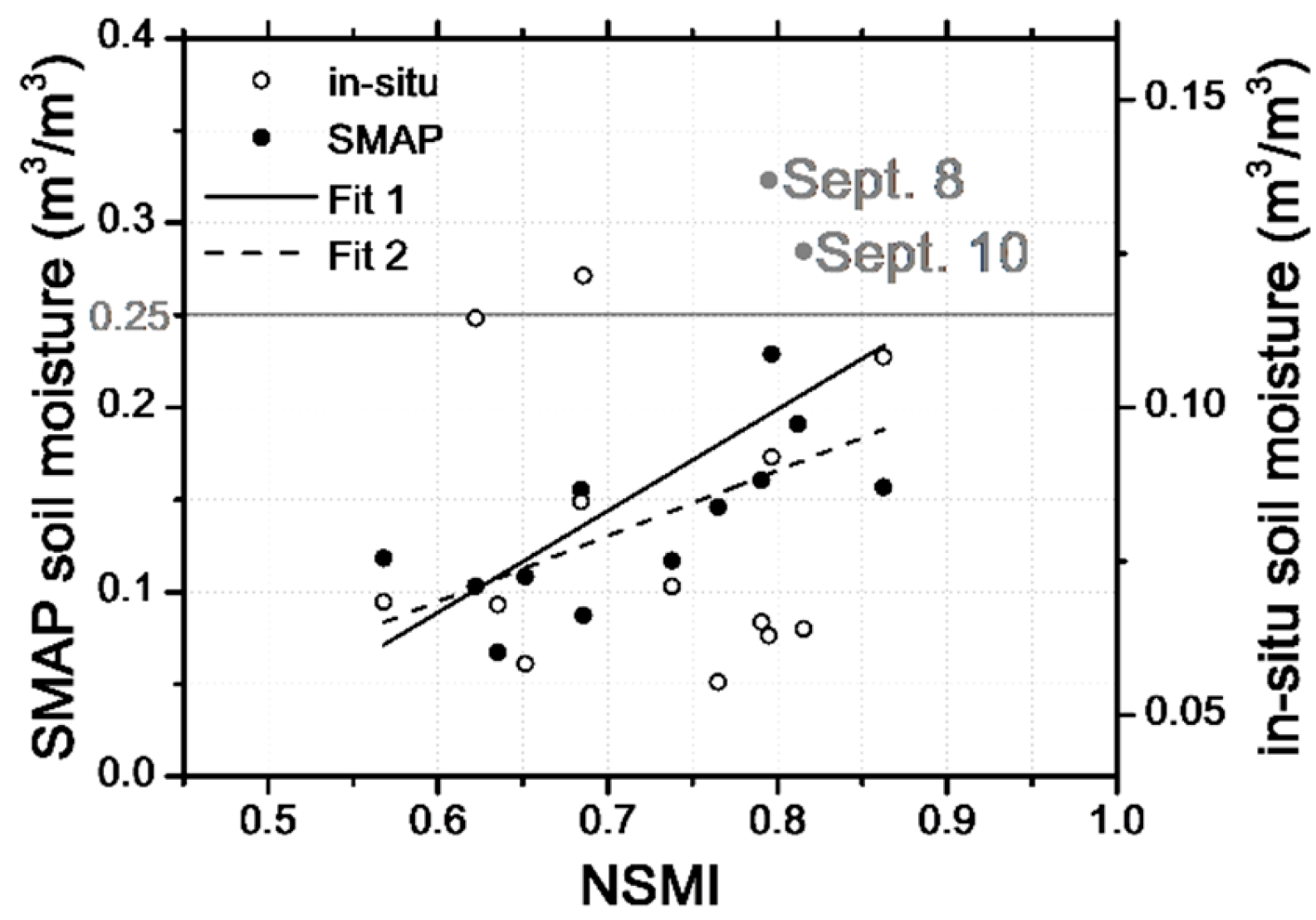
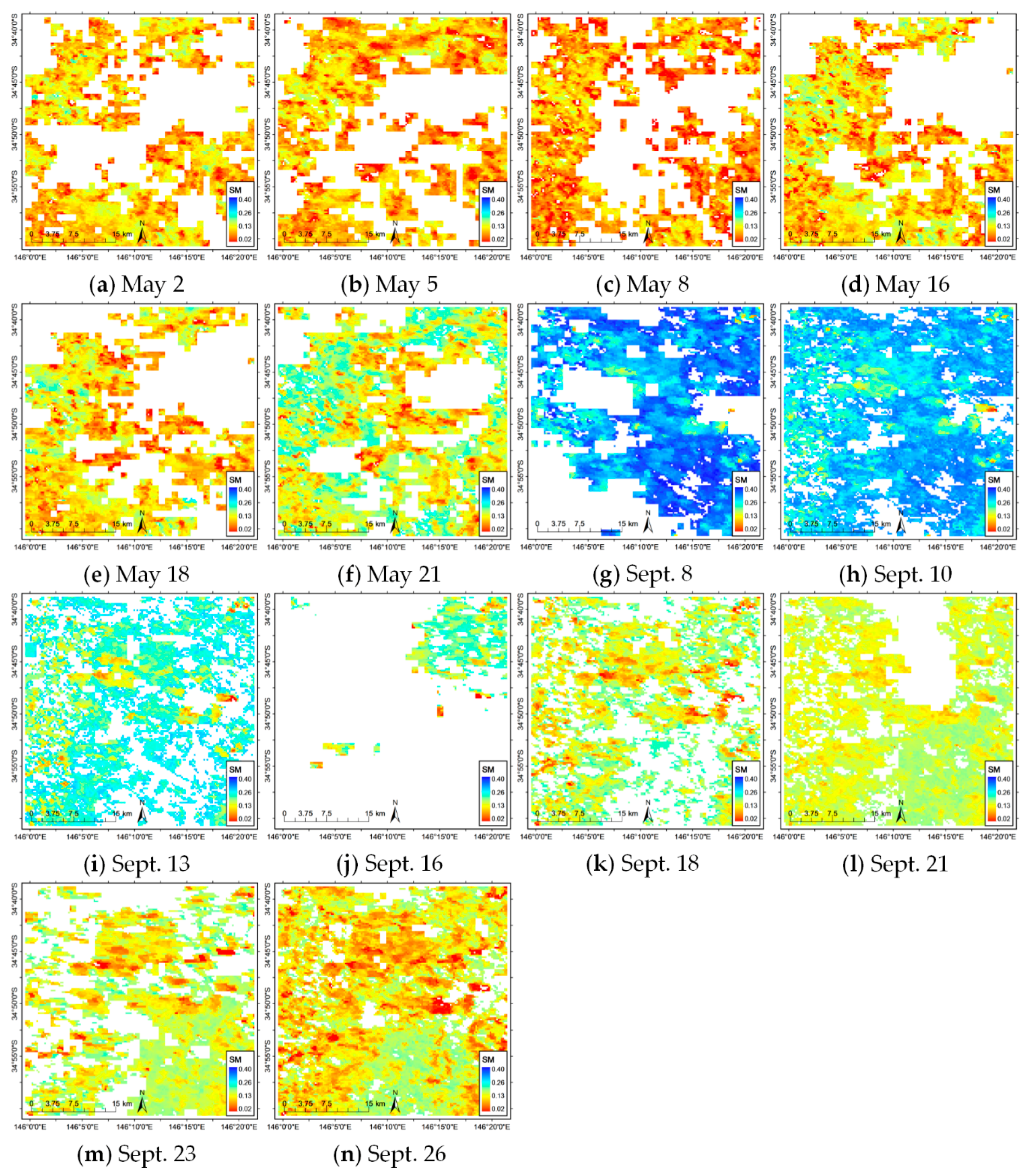
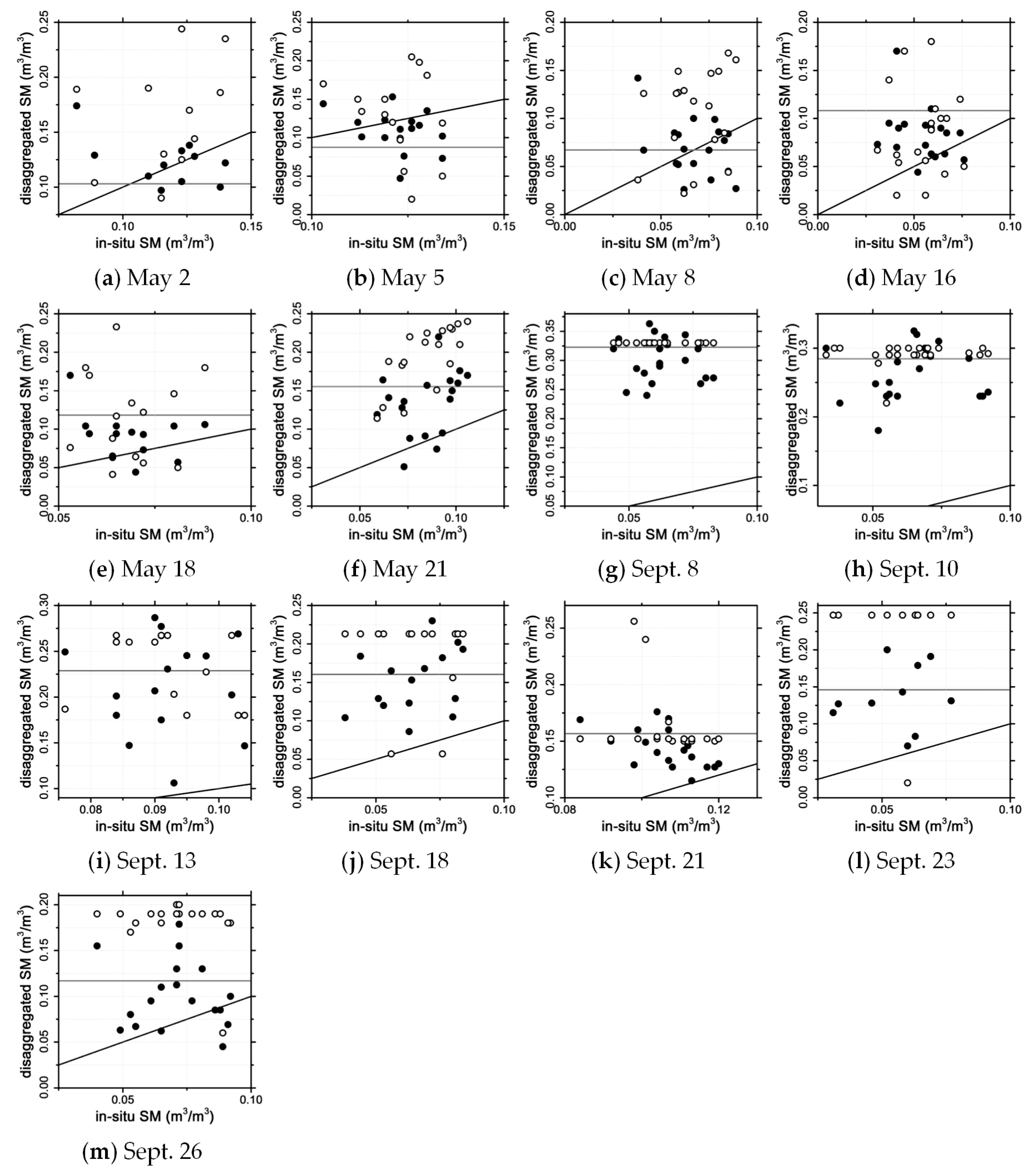

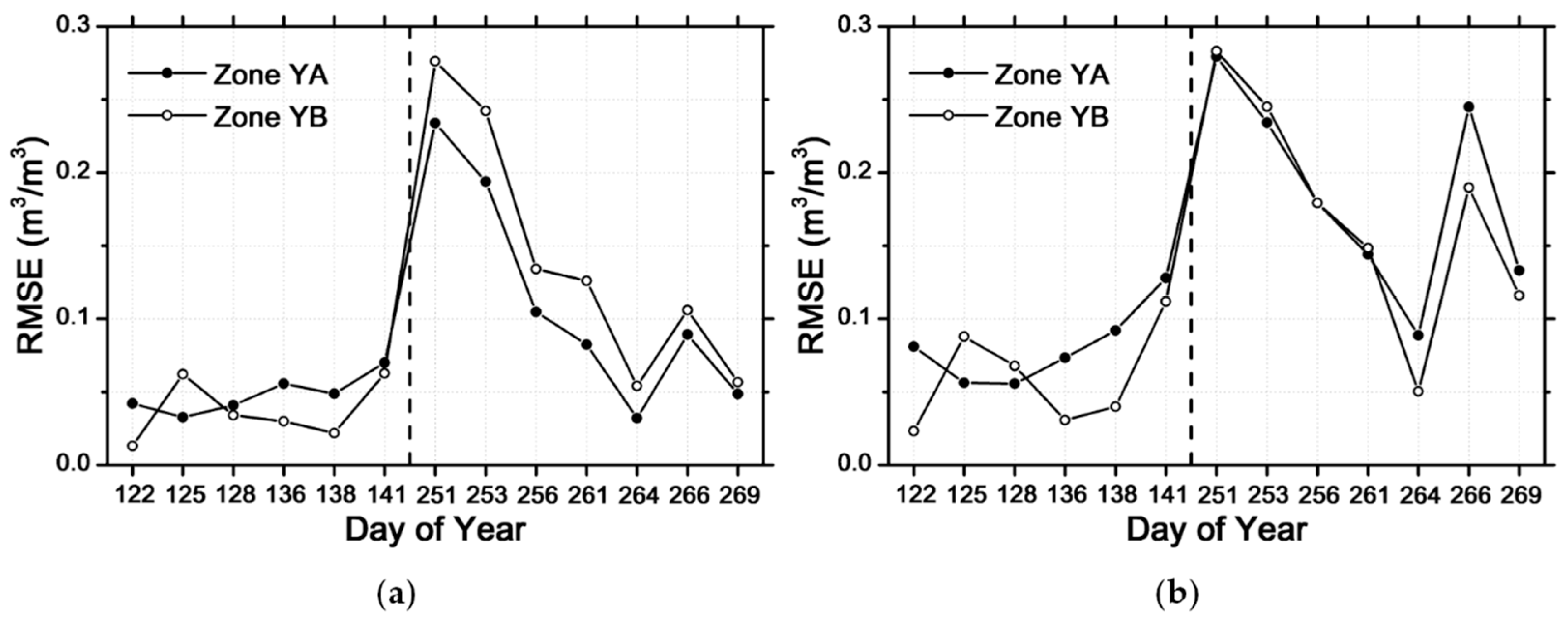

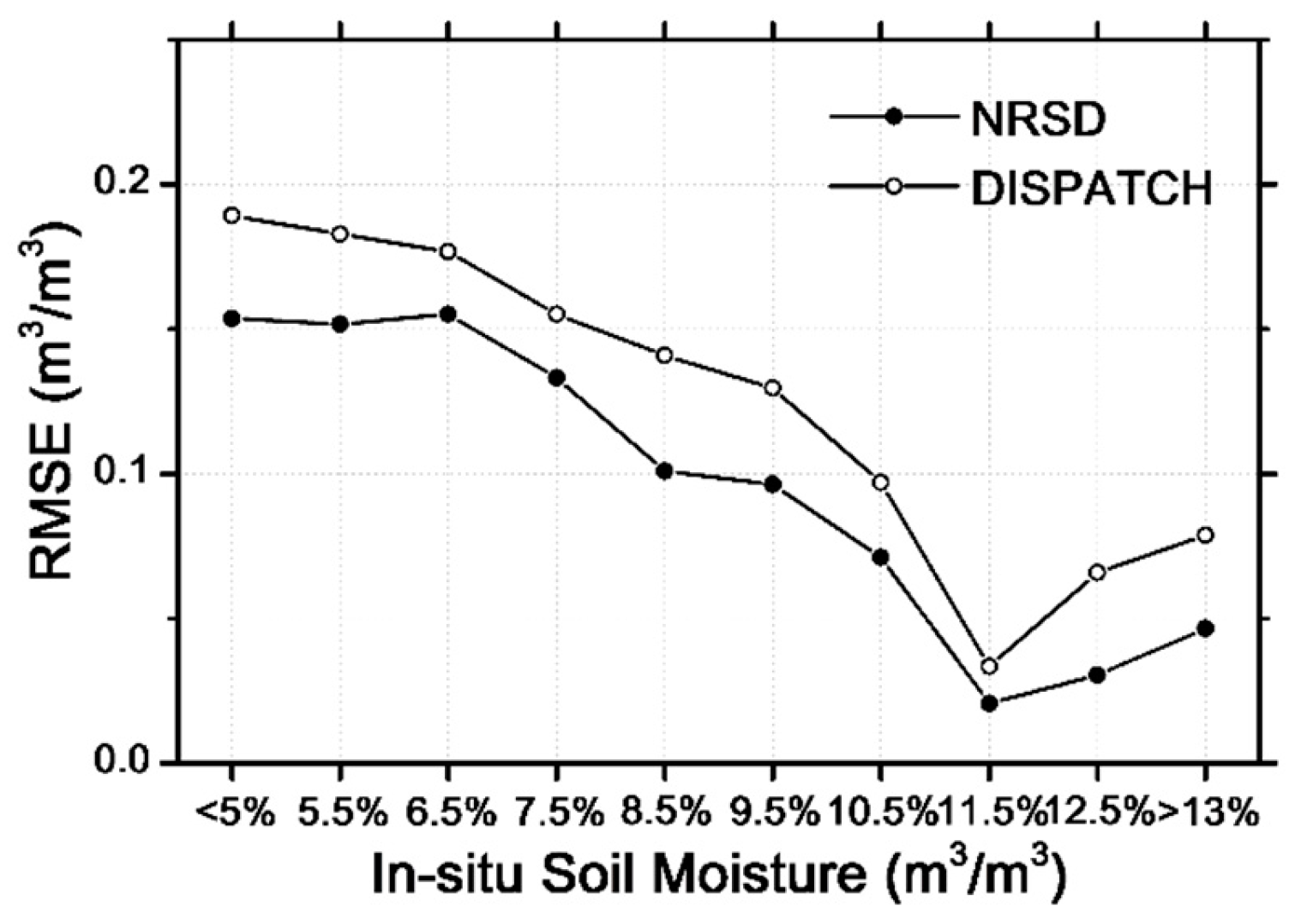
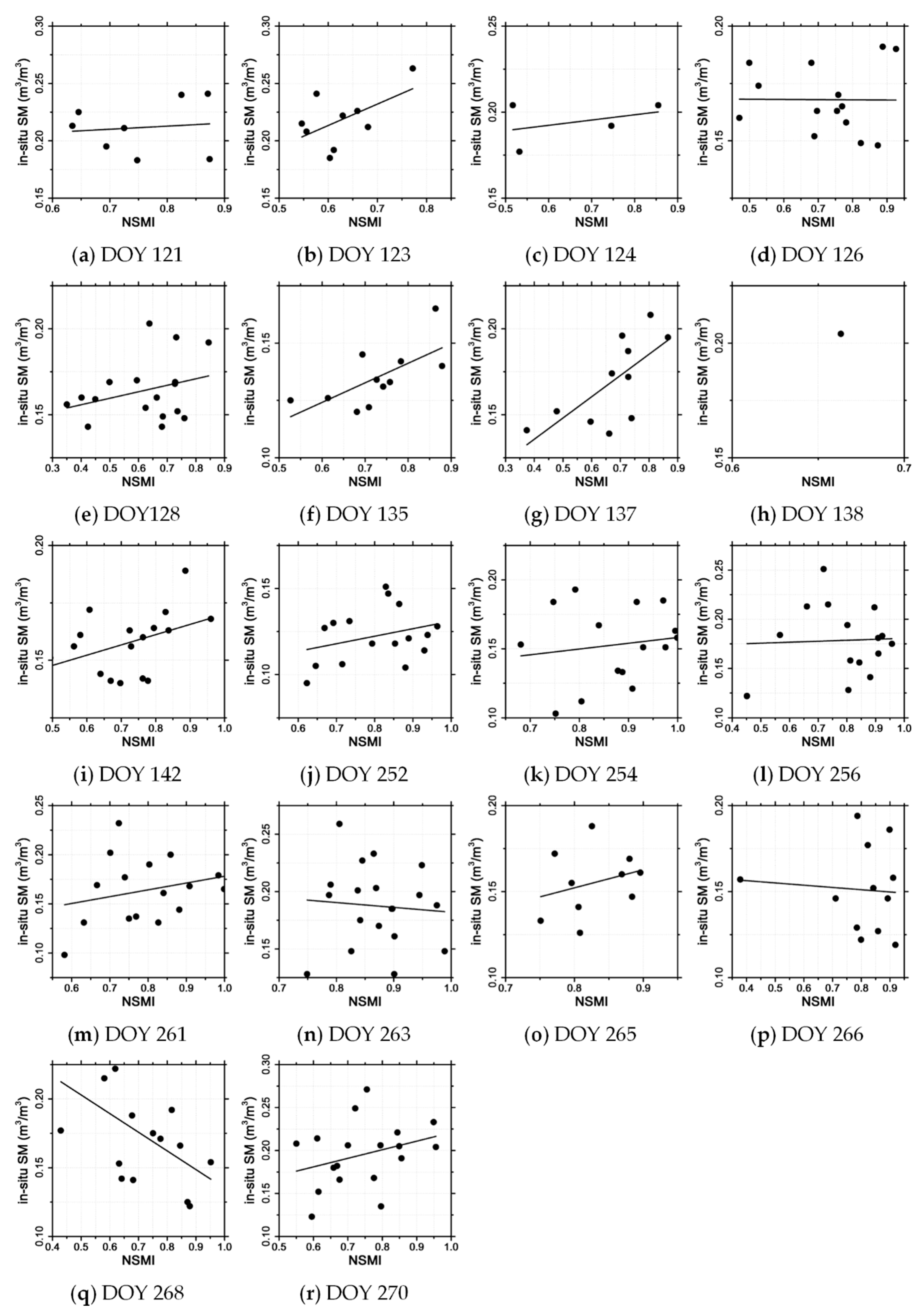
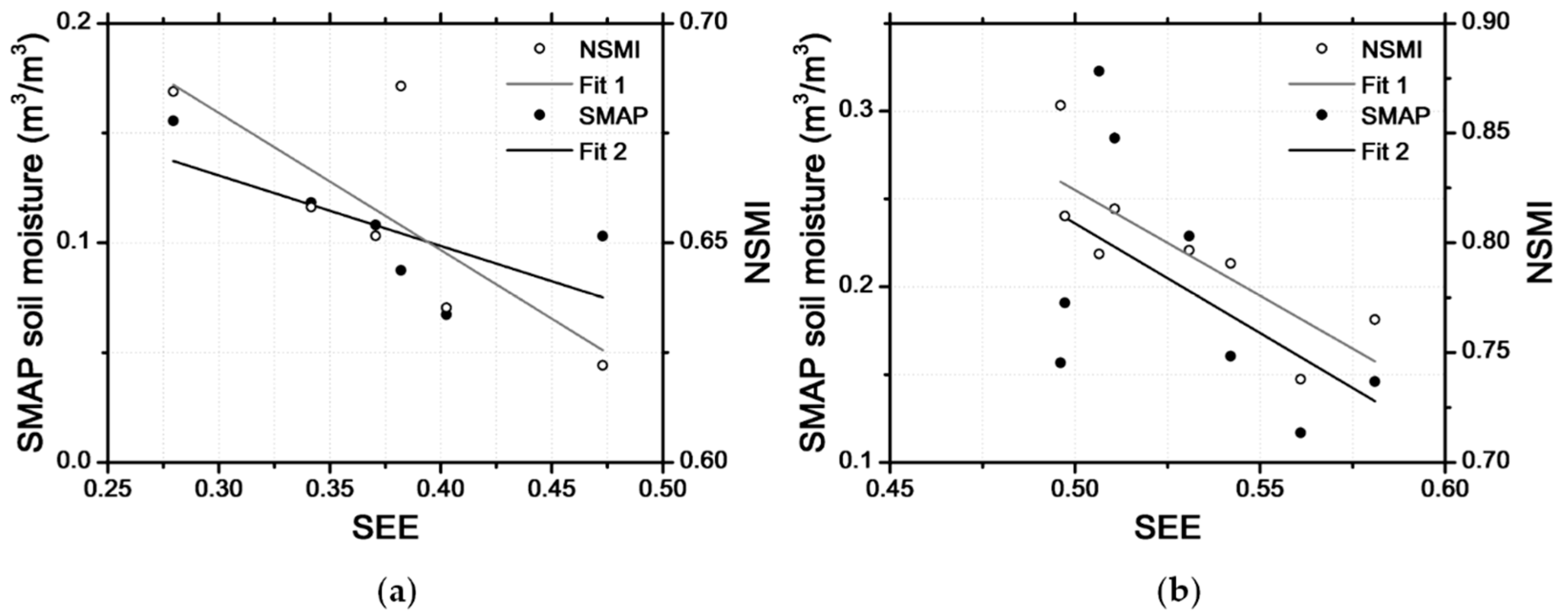
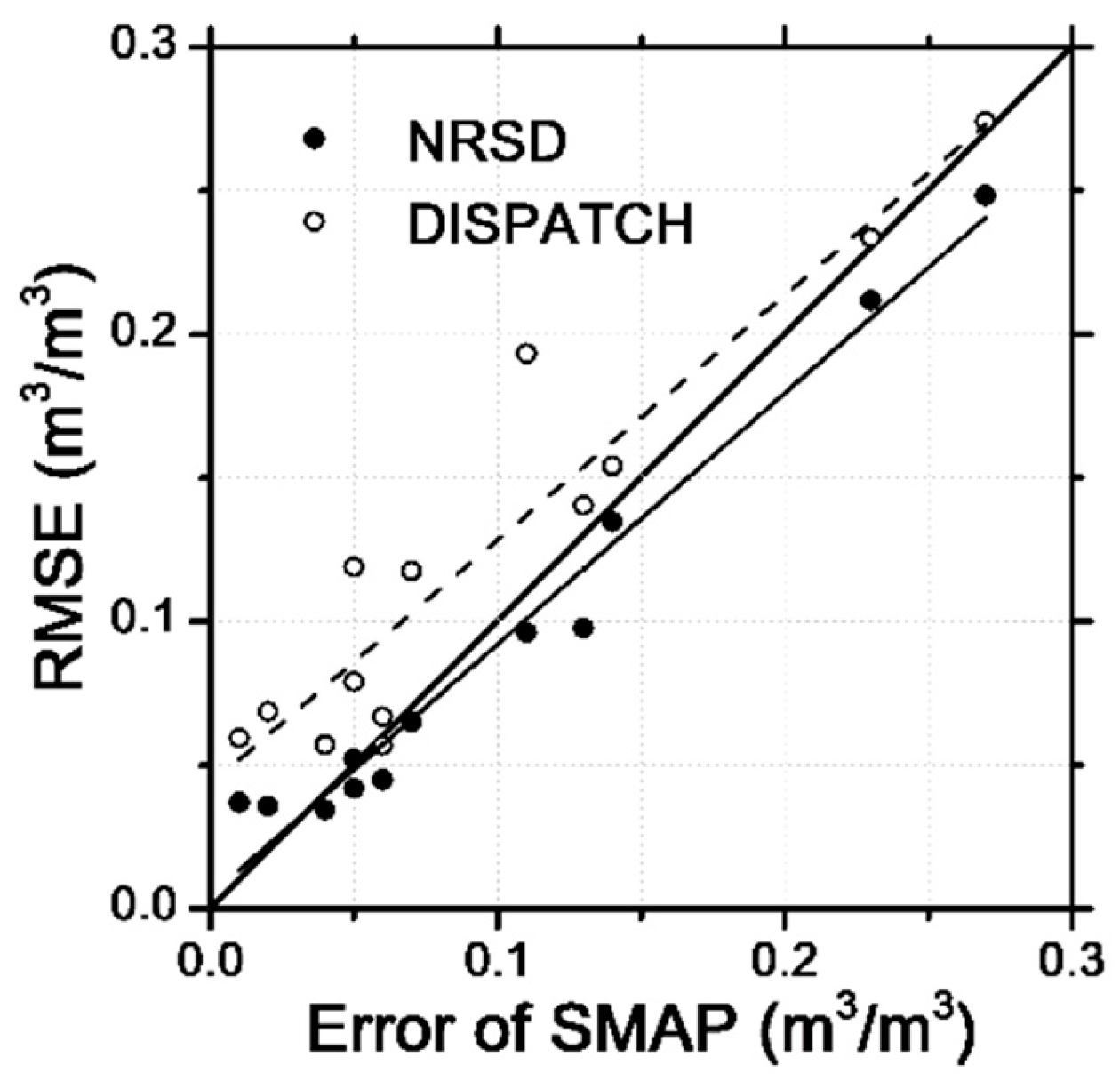
| Overpass Day 1 | DOY 2 | Cloud Condition 3 | MODIS Data Input 4 | Overpass Day | DOY | Cloud Condition | MODIS Data Input |
|---|---|---|---|---|---|---|---|
| 2 May | 121 | √ | √ | 8 September | 250 | X | X |
| 122 | X | X | 251 | X | X | ||
| 123 | √ | √ | 252 | √ | √ | ||
| 5 May | 124 | √ | √ | 10 September | 252 | √ | √ |
| 125 | X | X | 253 | X | X | ||
| 126 | √ | √ | 254 | √ | √ | ||
| 8 May | 128 | √ | √ | 13 September | 256 | √ | √ |
| 16 May | 135 | √ | √ | 16 September | 259 | √ | √ |
| 136 | X | X | 18 September | 261 | √ | √ | |
| 137 | √ | √ | 21 September | 263 | √ | √ | |
| 18 May | 137 | √ | √ | 264 | X | X | |
| 138 | √ | √ | 265 | √ | √ | ||
| 139 | X | X | 23 September | 266 | √ | √ | |
| 21 May | 140 | X | X | 26 September | 268 | √ | √ |
| 141 | X | X | 269 | X | X | ||
| 142 | √ | √ | 270 | √ | √ |
| Overpass Day | NOIS 1 | NRSD | DISPATCH | SMAP | |||||||||
|---|---|---|---|---|---|---|---|---|---|---|---|---|---|
| RMSE | Bias | bVariance | R | p | RMSE | Bias | bVariance | R | p | RMSE | Bias | ||
| 2 May | 11 | 0.04 | 0.01 | 0.33 | –0.6 | 0.08 | 0.07 | 0.05 | 3.07 | 0.33 | 0.33 | 0.02 | –0.01 |
| 5 May | 15 | 0.03 | –0.01 | 1.87 | –0.3 | 0.22 | 0.06 | 0.01 | 4.43 | –0.3 | 0.35 | 0.04 | –0.03 |
| 8 May | 18 | 0.04 | 0.01 | 1.39 | –0.4 | 0.15 | 0.06 | 0.04 | 3.13 | 0.25 | 0.31 | 0.01 | –0.01 |
| 16 May | 18 | 0.04 | 0.03 | 1.41 | –0.3 | 0.22 | 0.06 | 0.03 | 3.24 | 0.05 | 0.83 | 0.06 | 0.05 |
| 18 May | 14 | 0.04 | 0.02 | 2.01 | –0.3 | 0.23 | 0.08 | 0.05 | 4.7 | –0.1 | 0.95 | 0.05 | 0.05 |
| 21 May | 18 | 0.06 | 0.05 | 2.64 | 0.33 | 0.18 | 0.11 | 0.11 | 2.55 | 0.72 | 0.01 | 0.07 | 0.07 |
| 8 September | 21 | 0.24 | 0.24 | 2.49 | –0.1 | 0.62 | 0.27 | 0.27 | - | 0 | 1 | 0.27 | 0.26 |
| 10 September | 22 | 0.21 | 0.20 | 2.19 | 0.10 | 0.98 | 0.23 | 0.23 | 0.03 | 0.11 | 0.61 | 0.23 | 0.22 |
| 13 September | 15 | 0.13 | 0.12 | 4.37 | 0.02 | 0.95 | 0.15 | 0.14 | 2.92 | –0.3 | 0.30 | 0.14 | 0.14 |
| 16 September | 0 | - | - | - | - | - | - | - | - | - | - | - | - |
| 18 September | 15 | 0.09 | 0.09 | 2.64 | 0.34 | 0.21 | 0.14 | 0.12 | 3.95 | –0.1 | 0.72 | 0.13 | 0.13 |
| 21 September | 19 | 0.05 | 0.04 | 0.78 | –0.5 | 0.01 | 0.07 | 0.06 | 2.08 | –0.3 | 0.22 | 0.06 | 0.05 |
| 23 September | 10 | 0.09 | 0.08 | 2.68 | 0.15 | 0.67 | 0.19 | 0.17 | 5.39 | –0.1 | 0.76 | 0.11 | 0.10 |
| 26 September | 18 | 0.05 | 0.03 | 2.09 | –0.2 | 0.55 | 0.12 | 0.11 | 1.52 | –0.3 | 0.28 | 0.05 | 0.05 |
| Mean | May | 0.04 | 0.02 | 1.61 | - | - | 0.07 | 0.05 | 3.52 | - | - | 0.04 | 0.02 |
| September | 0.12 | 0.11 | 2.46 | - | - | 0.17 | 0.16 | 2.65 | - | - | 0.14 | 0.14 | |
| DOY | SMAP Soil Moisture | NSMI36km | Number of In Situ Sites | R-Value | Slope | p-Value |
|---|---|---|---|---|---|---|
| 121 | 0.10 | 0.65 | 8 | 0.11 | 0.03 | 0.79 |
| 123 | 0.10 | 0.60 | 9 | 0.55 | 0.19 | 0.12 |
| 124 | 0.09 | 0.68 | 4 | 0.40 | 0.13 | 0.60 |
| 126 | 0.09 | 0.69 | 14 | 0.01 | 0.01 | 0.97 |
| 128 | 0.07 | 0.64 | 17 | 0.31 | 0.13 | 0.21 |
| 135 | 0.11 | 0.67 | 11 | 0.67 | 0.09 | 0.02 |
| 137 | 0.11 | 0.63 | 11 | 0.70 | 0.12 | 0.01 |
| 138 | 0.12 | 0.57 | 1 | - | - | - |
| 142 | 0.16 | 0.68 | 18 | 0.40 | 0.06 | 0.10 |
| 252 | 0.32 | 0.79 | 17 | 0.31 | 0.05 | 0.25 |
| 254 | 0.28 | 0.81 | 16 | 0.15 | 0.07 | 0.59 |
| 256 | 0.23 | 0.80 | 15 | 0.04 | 0.03 | 0.89 |
| 259 | 0.19 | 0.81 | 0 | - | - | - |
| 261 | 0.16 | 0.79 | 17 | 0.25 | 0.07 | 0.35 |
| 263 | 0.16 | 0.86 | 19 | −0.1 | −0.04 | 0.75 |
| 265 | 0.16 | 0.86 | 10 | 0.30 | 0.11 | 0.43 |
| 266 | 0.15 | 0.77 | 12 | −0.1 | −0.03 | 0.81 |
| 268 | 0.12 | 0.73 | 15 | −0.5 | −0.14 | 0.05 |
| 270 | 0.12 | 0.75 | 18 | 0.31 | 0.10 | 0.20 |
© 2017 by the authors; licensee MDPI, Basel, Switzerland. This article is an open access article distributed under the terms and conditions of the Creative Commons Attribution (CC-BY) license (http://creativecommons.org/licenses/by/4.0/).
Share and Cite
Chen, N.; He, Y.; Zhang, X. NIR-Red Spectra-Based Disaggregation of SMAP Soil Moisture to 250 m Resolution Based on OzNet in Southeastern Australia. Remote Sens. 2017, 9, 51. https://doi.org/10.3390/rs9010051
Chen N, He Y, Zhang X. NIR-Red Spectra-Based Disaggregation of SMAP Soil Moisture to 250 m Resolution Based on OzNet in Southeastern Australia. Remote Sensing. 2017; 9(1):51. https://doi.org/10.3390/rs9010051
Chicago/Turabian StyleChen, Nengcheng, Yuqi He, and Xiang Zhang. 2017. "NIR-Red Spectra-Based Disaggregation of SMAP Soil Moisture to 250 m Resolution Based on OzNet in Southeastern Australia" Remote Sensing 9, no. 1: 51. https://doi.org/10.3390/rs9010051






